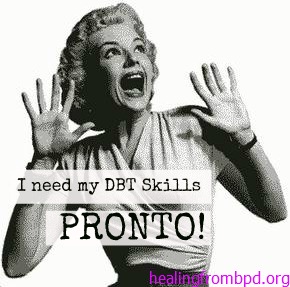CBT + Zen = DBT (a quick guide)
Some time ago on when I was on the Welcome to Oz (WTO) Internet group, I started posting about the benefits of DBT (Dialectical Behavior Therapy) for treatment of Borderline Personality Disorder (BPD). I have since left that group and started my own (the ATSTP Google Group). However, at WTO the discussion turned to DBT and its effectiveness (or lack thereof). There is one member of WTO who came down against all behavioral therapies. He posted the following message as a follow up to a message about DBT:
DBT is a behavioral therapy.
The idea is to learn a new behavior by repeated conditioning.
“Fake it until you make it”
It can be effective…Pavlov showed that a lower species can
learn through behavior therapy.The question is then…is there a better way?
My thought…learn what you need before seeking a product….then buyer beware.
My reaction to this message was complete disbelief. I can only suppose that this guy (who is a Christian BTW) doesn’t believe that humans are in the category of “lower species” (probably because they have a soul and are made in the image of God, as opposed to animals). Of course, his alternative (or “better way”) was his personal belief in Transactional Analysis (popularized by “I’m OK, You’re OK” in the 70s) and the “inner child vs. inner adult” dynamic. That is garbage and hasn’t been shown to be effective with BPD at all.
So, how does DBT work?
DBT is a behavioral therapy. It teaches skills to modify a person’s behavior. Basically, the client begins to behave in a fashion that is different that the behavior that they previously exhibited. The purpose is behavioral modification. The new behavior becomes reconditioned over the old behavior. There person become “retrained.” One of the main problem with BPD is poor/ineffective behavior. If the behavior can be modified, the results of the behavior will not exist. In other words, if you choose NOT to cut yourself, you will not have to go to the hospital and get stitches. Interestingly, I find that this “theory” follows the Buddhist idea of “dependent arising” – which governs “conditioned existence.” That idea is formulated as follows:
When this is, that is.
From the arising of this comes the arising of that.
When this isn’t, that isn’t.
From the cessation of this comes the cessation of that.
See this Wikipedia entry for more information.
DBT functions in four general areas:
- Core Mindfulness
- Distress Tolerance
- Emotional Regulation
- Interpersonal Effectiveness
One of the differences between DBT and CBT is that DBT emphasizes acceptance of certain things versus complete change. Why? Here is one explanation from Marsha Linehan in the interview with David Van Nuys on “Wise Counsel”:
Dr. Marsha: All right. DBT or Dialectical Behavior Therapy is an integration of two major approaches. The first approach is the approach of cognitive-behavioral therapy.
Dr. David: OK.
Dr. Marsha: So, it contains within that sort of standard cognitive-behavioral therapy or behavior therapy. As behavior therapy changes and improves, DBT changes right along with behavior therapy, cognitive-behavioral therapy and improve.
Dr. David: OK.
Dr. Marsha: Then it balances a technology of change with the corresponding technology of acceptance. The acceptance is a derivative primarily from contemplative spiritual practices of Zen, primarily, but also other contemplative practices. Mindfulness, mindfulness-based practices and also validation of clients.
The acceptance end of the treatment is two-part. It’s a radical acceptance of a client as the client is at this moment by the therapist and teaching the client the same corresponding ability to radically accept. The reason it’s called “dialectical” is because it’s a synthesis of acceptance and change. Back and forth, a constant transaction interplay all the time.
Dr. David: Yes, when I first heard the term “dialectical, ” of course, I immediately thought of Hegel and Karl Marx and so I wasn’t quite sure of what the relationship was but they did talk about synthesis and antitheses and then the… Have I got that right?
Dr. Marsha: Yeah, it’s the theses…
Dr. David: Theses and antitheses.
Dr. Marsha: The antitheses and then the synthesis. The notion is, “everything contains within it its opposite, ” which really means that nothing exists really without an opposite of it. Even if you take something as mundane as a box, there couldn’t be a box if there wasn’t a non-box, a no-box, a not-box, because a box is very defined as it’s this so there’s obviously something that’s not a box.
Everything that exists has its opposite and Dialectics looks at the tension between; what exists and its opposite, or the theses and the antitheses or the opposite, and looks at the transaction between them, and that tension and that transaction which always brings about change.
Dr. David: In terms then of your therapeutic work and your therapy model, what are those two poles of tension?
Dr. Marsha: Oh, there are many. There are many, many, many poles. One of the most fundamental poles is that within every unwise act, there is some inherent wisdom. Taking heroin, which is long term, a dysfunctional, destructive behavior in our culture. Within there, is the wisdom of, “You feel better immediately.” So there is dysfunction and function always coexisting together.
The tension is finding the synthesis of; “Are there other ways for example?” or “How to radically accept that if one’s in great pain, getting out of pain is reasonable” while at the same time accepting that if one is in great pain, getting out of great pain by doing something that will continue to pain in the future is not reasonable. You’re always looking for a synthesis, where is a point that without rejecting the other side.
Here is another explanation of why acceptance was inserted into DBT by Marsha Linehan:
Dialectical Behavior Therapy represents an integration of two traditions: the behavior and cognitive-behavioral therapy tradition which is focused on developing technologies of change, and the mindfulness tradition that comes out of various spiritual practices including Zen Buddhism and contemplative Christian practices. At the start of her career, Dr. Linehan set out to develop a treatment for chronically suicidal patients and found that many of them were so overwhelmed by significant problems that it was not possible to address them all. Instead of focusing solely on how patients could change, what was required was also to help patients to better tolerate their circumstances. She was familiar with Christian contemplative spiritual practices that emphasized surrender to God, but sought out alternative teachers (e.g., a Zen Buddhist and a Benedictine Monk) who could teach her a “technology of acceptance” that would be more free of particular religious overtones. After taking several months to immerse herself in acceptance practices, she began the task of translating them into a language that behaviorists could accept and DBT was born. Though at first she thought the therapy was for suicidal people, in 1980 when the diagnosis of Borderline Personality Disorder was added to the DSM, she realized that it was really a therapy made for treating BPD and similar sorts of issues.
So, through applying behavioral change (from CBT) and acceptance (from Buddhist practice) DBT effectively treats BPD (and similar sorts of issues).



4 Comments
Wandering Coyote
Thanks for this post – it’s excellent.
Having completed a 32-week DBT program, I can tell you first hand that it is an excellent therapy that can make vast changes.
I find Linehan to be a bit hard to read…Her language needs simplification, IMO, but her work is amazing.
Acceptance is a tough one – perhaps the toughest. We so desperately want to change something, or rail against something, or whatever…It’s almost instinctual to want to fix something that’s broken or not working. Sometimes, accepting feels like settling, too. It’s a fine line to draw. BUT, acceptance is practical. We know rationally and intellectually that some things JUST ARE, no matter what we do or how badly we want to change or fix them. But rather than settling, I think acceptance is about letting go, and that’s a lesson so many of us need to learn…
Bon Dobbs
WC,
Hi. Thanks for the comment. My daughter is in a “pre-DBT” program and it has helped a lot. There are other adolescents in the program that talk with her when she’s there. She still struggles with her emotions, but she is vastly improved over when she started 16 months ago.
Linehan does seem to use some complex language. Have you seen her videos though? There a link to some video transcripts on dbtselfhelp.com, but it appears to be down right now.
When she talk directly to someone with BPD, she is not as academic in her language. Still, she can be tough on her clients as well. I’ve seen a number of her therapy session (they are reenacted) and she is a little validating, but stays on the point with her client. Interesting really.
As for acceptance, yes, it is tough. However, if you don’t accept the things that you cannot change, you’re in for a ton of frustration – you know? I think this is one of the things that really gets to the Non-BPs. They’re never sure what they can affect change over and what they can’t.
mindfulness based cognitive therapy
By paying attention to our thoughts, and learning how to change those that are destructive, we are inevitably facing off a very strong force in our minds. Years and sometimes decades of beliefs, habits and subconscious negativity can not be erased or changed overnight, but with constant application of cognitive therapy techniques, change can be obvious within a few short months.
david1563
Who was the Benedictine Monk? I lived in a Benedictine College around the time Dr. Linehan was developing DBT a little South of Seattle. That’s the only Benedictine Monastery in the area. I wonder if there is a connection.